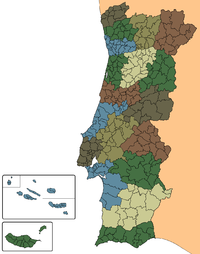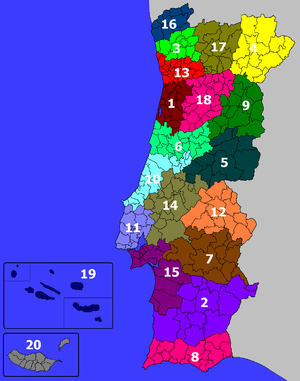- Municipalities of Portugal
-
Municipality 
Also known as Concelho Category 2nd-level administrative division Location Portugal Found in District
Autonomous RegionCreated Middle Ages Number 308 Populations 451–529,485 Areas 7.9–1,720.6 km² Government Municipal Chamber
Municipal AssemblySubdivisions Parish In Portugal, municipality (município) or concelho is the most stable subdivision of Portugal since the foundation of the country.
Portugal has an entirely separate system of cities and towns. Cities and towns are located in municipalities, but often do not have the same boundaries, even if built-up is continuous. In total there are around twice as many cities and towns as there are municipalities.
As a general rule, each municipality is further subdivided into parishes (freguesias); the municipalities in the north of the country usually have a higher number of parishes. Five municipalities are composed of only one parish, and Barcelos is the municipality with most parishes, with 89. Corvo is, by law, the only municipality with no parishes.
Contents
History
The municipality has been the most stable subdivision of Portugal since the foundation of the country in the 12th century. They have their origin in the foral, a legal document, issued by the king, which assigned privileges to a town or a region. The present subdivisions have their origins in the 19th century.
The concelhos probably formed after the expulsion of the Visigothic rulers by the Moors during the Umayyad conquest of Hispania. Towns were thus left free to govern themselves, the population started to organize in councils (concelhos in Portuguese) in order to govern the town and surrounding lands. These were also a reminder of Roman municipalities.
Most municipalities have their origin in the foral, a legal document, issued by the king, which assigned privileges to a town or a region. The present subdivisions have their origins in the 19th century, after the administrative reforms conducted by the middle of 19th century, by the governments of the Constitutional Monarchy.
In 1910, the Republic was instaured in Portugal. By the end of 19th century, the republicans promised a federal organization for the Portuguese territory — that the country would become a municipal republic. However, when the Republic was formed, they did not adopt what they promised for almost half a century.
Later in the end of the 20th century, democracy has granted some autonomy to municipalities. Since the creation of a democratic local administration, in 1976, the Portuguese municipalities have been ruled by a system composed by an executive body (the municipal chamber) and a deliberative body (the municipal assembly).
The municipal chamber is the executive body, and is composed of the president of the municipality and a number of councillors proportional to the municipality's population. The municipal assembly is composed of the presidents of all the parishes that compose the municipality, and by a number of directly elected deputies which is at least equal to the number of parish presidents plus one. Both bodies are elected to a 4-year term.
Traditionally, the north and the autonomous regions are politically more conservative, while the south and the region of Lisbon are dominated by the left.
In 1991, two áreas metropolitanas (meaning "metropolitan areas") were created for the two major cities of the country (Lisbon and Porto).
Geography
Portugal is divided into 18 districts (Portuguese: distritos) and 2 autonomous regions (Portuguese: regiões autónomas), Azores and Madeira. The districts and autonomous regions are further sub-divided into 308 municipalities (Portuguese: municípios or concelhos). The municipality is, usually, much larger than the city or town after which it is named.
District / Autonomous region Municipalities 1. Aveiro 19 2. Beja 14 3. Braga 14 4. Bragança 12 5. Castelo Branco 11 6. Coimbra 17 7. Évora 14 8. Faro 16 9. Guarda 14 10. Leiria 16 11. Lisbon 16 12. Portalegre 15 13. Porto 18 14. Santarém 21 15. Setúbal 13 16. Viana do Castelo 10 17. Vila Real 14 18. Viseu 24 19. Açores 19 20. Madeira 11 The biggest municipalities are those located in rural and inland areas where the dominating property type is the latifundia, such as Beja, Évora or Portalegre in the south, and also in other less populated areas, such as Bragança or Castelo Branco.
The most populous municipalities are those located near the sea, and especially around the metropolitan areas of Lisbon, Porto and Braga, while the less populous municipalities are located in the inland regions of Alentejo and Trás-os-Montes. The municipalities with the lowest population densities are also found in these inland regions, with smaller populations distributed over a greater area.
Demographics
Denotes the number of inhabitants in the municipality area; area is in km2; only for populations of over 100,000 inhabitants.
Rank Municipality Population Land Area Density Metropolitan area 1 Lisbon 545,245 84.8 6,430 Greater Lisbon 2 Sintra 377,249 319.2 1,182 Greater Lisbon 3 Vila Nova de Gaia 302,092 170.8 1,769 Greater Porto 4 Porto 237,559 41.3 5,752 Greater Porto 5 Loures 205,577 169.3 1,214 Greater Lisbon 6 Cascais 205,117 97.4 2,106 Greater Lisbon 7 Braga 181,819 183.2 992 8 Amadora 175,558 23.8 7,376 Greater Lisbon 9 Matosinhos 174,931 62.2 2,812 Greater Porto 10 Almada 173,298 70.0 2,476 Greater Lisbon 11 Oeiras 172,063 45.7 3,765 Greater Lisbon 12 Gondomar 168,205 133.26 1,262 Greater Porto 13 Guimarães 158,108 241.3 655 14 Seixal 157,981 95.5 1,654 Greater Lisbon 15 Odivelas 143,755 26.4 5,445 Greater Lisbon 16 Coimbra 143,052 319.0 448 17 Santa Maria da Feira 139,393 215.1 648 Greater Porto 18 Vila Franca de Xira 136,510 317.7 430 Greater Lisbon 19 Maia 135,049 83.70 1,613 Greater Porto 20 Vila Nova de Famalicão 133,804 201.7 663 21 Leiria 127,468 564.7 226 22 Setúbal 120,791 171.9 703 Greater Lisbon 23 Barcelos 120,492 378.9 318 24 Funchal 112,015 76.25 1,469 See also
- Municipality
- List of municipalities of Portugal
- Subdivisions of Portugal
Articles on second-level administrative divisions of European countries Albania · Armenia2 · Austria · Belgium · Bosnia and Herzegovina · Bulgaria · Croatia · Cyprus2 · Czech Republic · Denmark · Estonia · Finland · France · Georgia3 · Germany · Greece · Hungary · Iceland · Italy · Kazakhstan · Kosovo4 · Latvia · Lithuania · Luxembourg · Malta · Moldova · Montenegro · Netherlands · Norway · Poland · Portugal · Romania · Russia · Serbia · Slovakia · Slovenia · Spain · Sweden · Switzerland · Turkey1 · Ukraine · United Kingdom
1 Has part of its territory outside Europe. 2 Entirely in West Asia, but considered European for cultural, political and historical reasons. 3 Partially or entirely in Asia, depending on the definition of the border. 4 Partially recognised.Categories:- Municipalities of Portugal
- Subdivisions of Portugal
- Country subdivisions of Europe
- Second-level administrative country subdivisions
Wikimedia Foundation. 2010.

